Introducing Chinese Herbal Chicken Soup – a soup that heals the mind, body and soul.
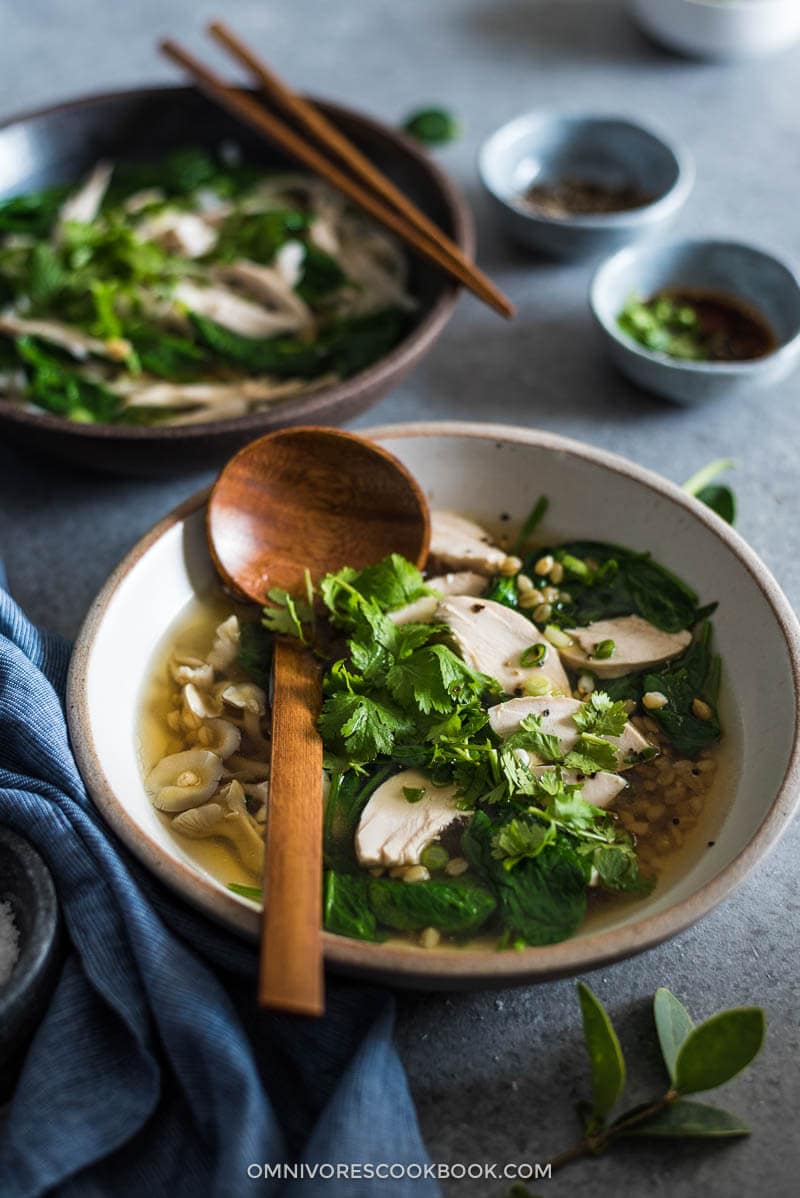
As a part of traditional Chinese cuisine, the use of food as a way of healing and nourishing the self (食疗, shi liao) is extremely vital to health and longevity.
Food and herbs have a synergetic effect, working together to draw out the benefits they otherwise wouldn’t release on their own. By combining them, they target certain health concerns such as digestive problems, headaches, or high blood pressure. The best part is, the entire healing process is all-natural and made with real, chemical-free food — no manufactured ingredients included.
The most popular form of Chinese healing food is slow-cooked soup (煲汤, bao tang). Whether it’s lovingly made for an older member of the family, a patient recovering from surgery, kids who are facing challenging exam or a new mom who’s nursing her baby, a bowl of slow-cooked chicken soup is just the right thing for feeling good.
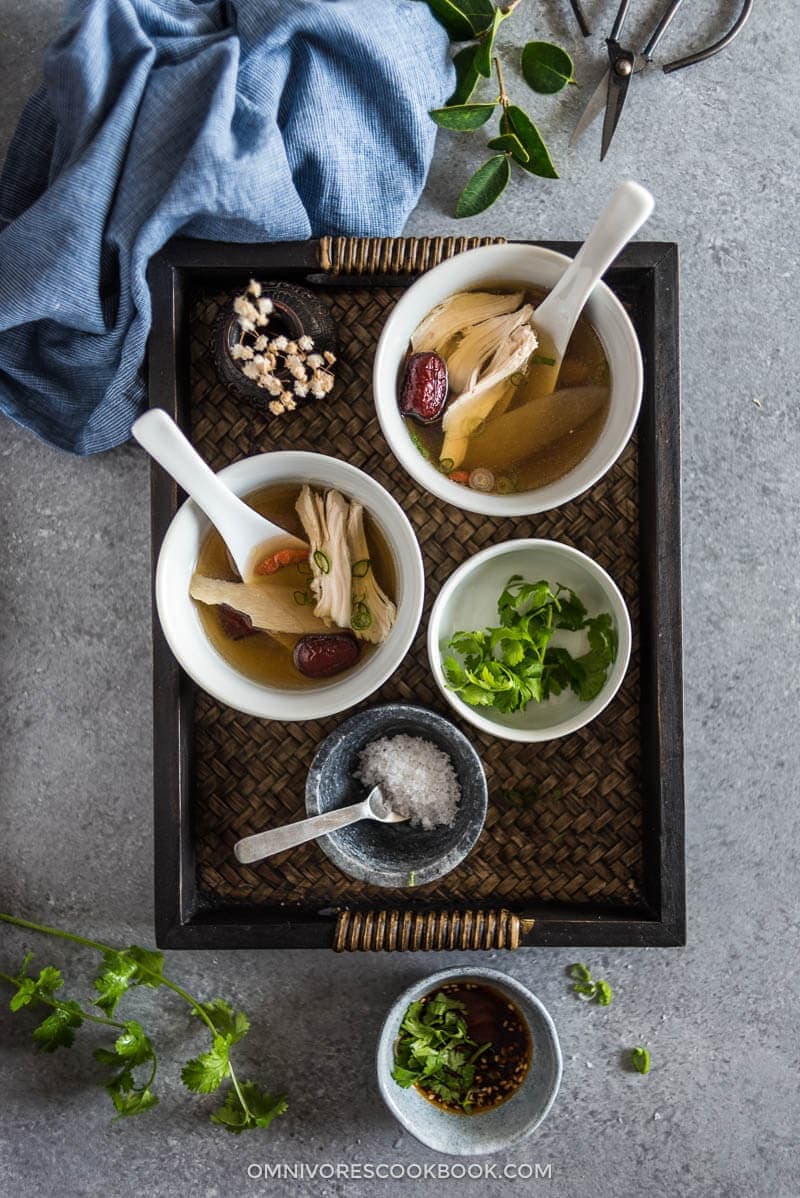
Not only is herbal soup one of the most popular dishes among Chinese people, it has started to gain much-merited attention in the western world as well. Last year, Chinese lady Tu Youyou won the Nobel Prize for medicine for her groundbreaking research into herbal medicine for healing malaria. Actress and food writer Gwyneth Paltrow has also famously blogged about herbal medicines. Recently I found out that even NFL quarterback Tom Brady’s health advisor and business partner is a Chinese medicine practitioner. I’m hoping that Chinese medicine becomes the next big trend after kale!
Chinese Herbal Soup Mix
There are many ways to design a herbal soup according to the specific health concerns you’d like to address.
For winter, we select ingredients that provide energy for our bodies to fight the extreme conditions: cold, snow, and wind. Winter is also a time when our body goes into hibernation mode and experiences a renewal process, much like how nature around is rebuilding herself for Spring. During this time it’s really important to nourish our bodies with nutrients and immunity boosters so our organs can keep us healthy and ready to bloom.
The herbs for winter soup include:
Astragalus Root (黄芪, Huang Qi) – Strengthens the inner energy of the body and boosts the immune system, increases energy levels and builds up resistance particularly when your immune system is lowered by overworking and stress.
Codonopsis Root (党参, Dang Shen) – An excellent anti-aging herb that helps combat tiredness, chronic fatigue, stress, adrenal fatigue and digestive problems.
Dried Chinese Yam (淮山, Huai Shan) – This herb enhances energy, aids digestion and absorption, repairs worn-out tissue, and helps alleviate bodily weakness.
Goji Berries (枸杞子, Gou Qi Zi) – Benefits the liver, which manifests in improving eyesight especially if poor eyesight is caused by malnutrition, vessel expansion, inflammation or eye strain from staring at computer screens and documents for long periods of time.
Longan (龙眼, Longyan) – Full of vitamins and containing active anti-aging ingredients, longan helps to promote restful sleep, replenishing blood and Qi.
Red Dates (红枣, Hong Zao) – Also known as jujubes, red dates are widely considered as the “living vitamin pill” by the Chinese. It contains Vitamin B, C, E, P, phosphorus, calcium, iron and more. It helps calm the central nervous system, protects the liver, inhibits cell mutation, and improves muscle strength.
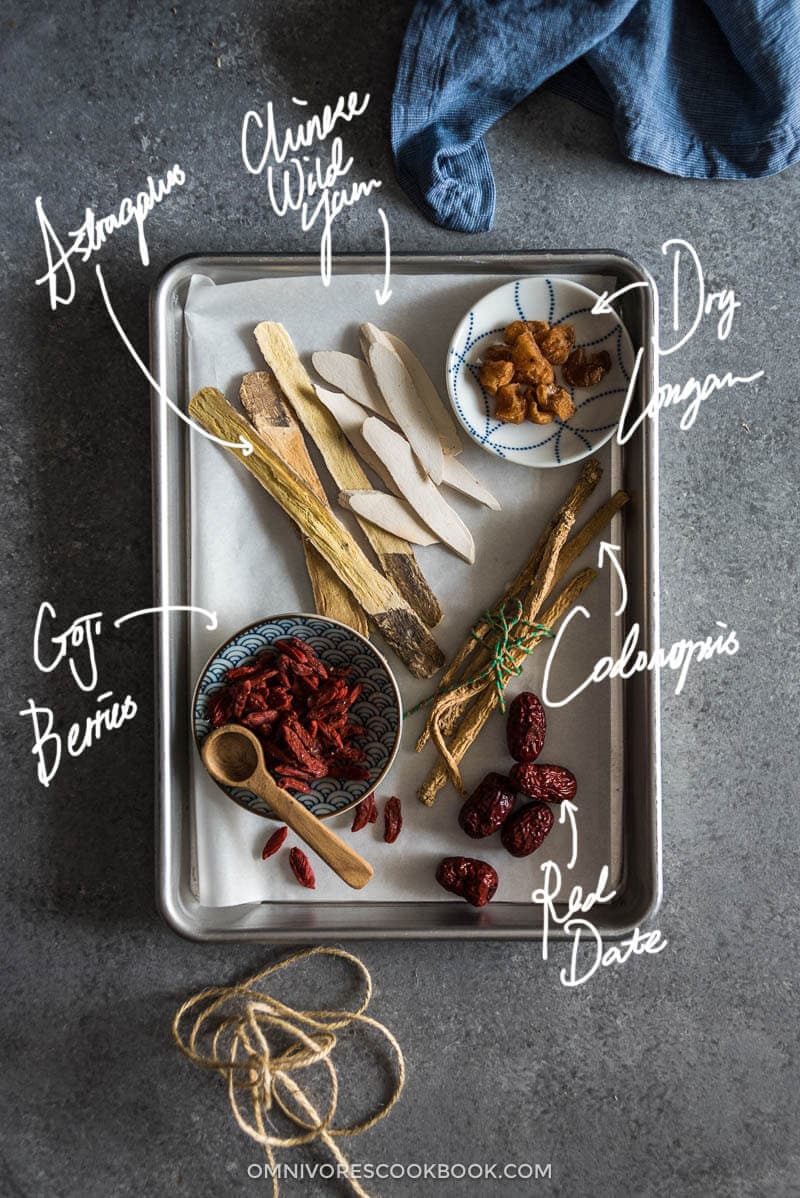
These six herbs are very common in Chinese cooking for preventing colds, boosting the immune system, and ingesting post-surgery to support recovery. Best of all they’re suitable for all ages! The ingredients naturally help flush toxins from the body and restore the Qi, which is necessary for feeling balanced and re-energized.
My personal favorite winter soup is cooking these fine herbs with either chicken or pork. In the southern parts of China (particularly the Cantonese region) where soup culture is the most entrenched, many people consume this kind of soup daily. Just as we use slow cooking here in the US, all the ingredients are added to a large clay pot or a electric cooker in the morning and left to cook all day. A pot of fresh and hot soup is ready just in time for dinner.
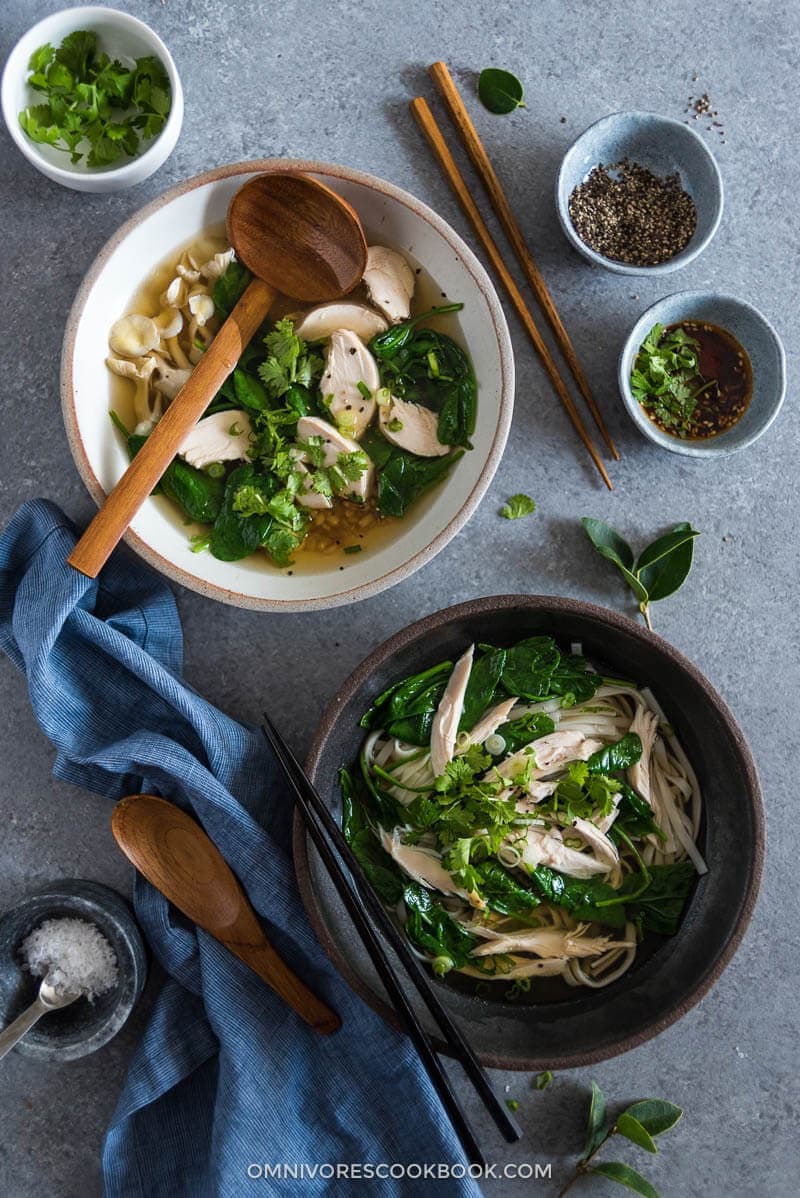
Herbal Mix – Where to buy
You can get each of these herbs in an Asian market or even on Amazon. However I highly recommend the herbal soup mix from Root and Spring. Root and Spring is an online store owned by the Mai family, who originate from Hong Kong. The Mai family ran a Chinese herbs store in Chinatown, NYC, and after moving to LA, they decided to open this online store to bring innovation and accessibility to traditional Chinese medicine. According to Cindy Mai, “the best, most reputable importers and manufacturers for Chinese medicine and herbs are in LA.”
There are a few benefits of the Root and Spring herbal soup mix:
- The soup mix is pre-portioned and prepped, so you can simply rinse and add chicken and water. That’s it!
- Each soup mix is designed by an expert herbalist in LA to guarantee the health benefit and good flavor.
- All the herbs are curated locally and hand crafted in small batches to maximize their freshness, so your soup will be extra fragrant.
- Every order comes with a recipe and information on the healing properties of each herb. No more guessing work while cooking!
I was so impressed with the freshness of these herbs. When I opened a bag, I immediately noticed an almost-sweet, fragrant nutty aroma. The semi-dried goji berries are plump with a vibrant color, and all the roots have been carefully cleaned, retaining their original light color. Compared with the herbs I got from my local Asian market, Root and Spring Soup mix is 10 times fresher.
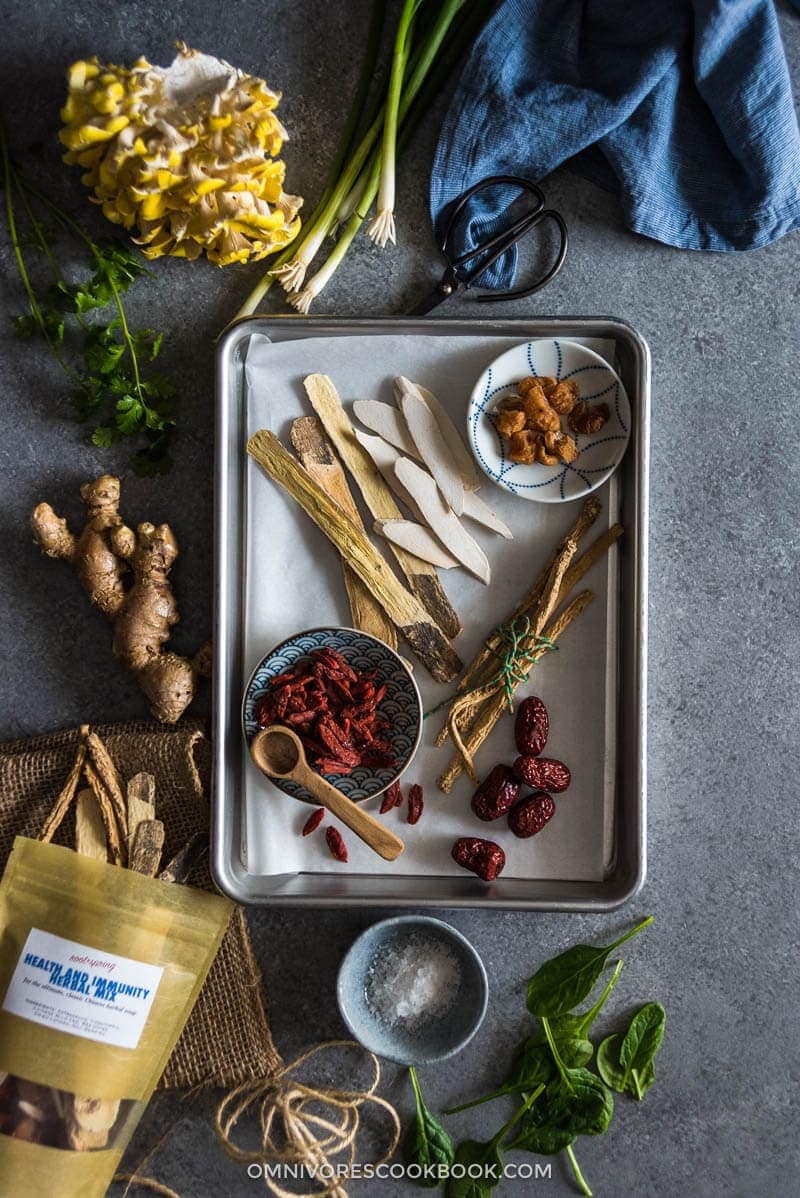
I’ve been obsessed with these soup mixes and have been drinking hearty chicken soups for a week. Most of the time I drink them on their own as a side dish, but when I want a quick and light meal, I throw in noodles and vegetables, to make a comforting noodle bowl. Sometimes I also add cooked whole grains, such as brown rice, barley, or wheat berries, to make it into a wholesome grain soup.
The herb mix I used in this recipe is The Chinese Herbal Soup Mix for Immunity & Health. You can purchase it here.
Cooking notes
- You can cook herbal chicken soup on a stovetop, in a slow cooker, or a pressure cooker. The cooking times are – 1.5 to 3 hours on stovetop, 2 to 8 hours in slow cooker, 20 to 30 minutes in pressure cooker.
- The herb mix is designed so that the longer you cook it, the darker, richer, and more herby it gets. If you’ve never tried Chinese herbal soup before, start from the minimum cooking time and taste the soup throughout the cooking process to figure out your favorite flavor.
- To serve the soup, simply add a pinch of salt and serve it as a side. I also like to spoon out the red dates, goji berries, and Chinese yam and serve them in the soup — so delicious!
- To make a quick one-bowl dinner, you can cook noodles or whole grains separately and add them into the soup. You can also boil some vegetables to add at the end of cooking.
- How to serve the boiled chicken 1: shred and serve in the soup. If the chicken tastes too plain, make a dumpling dipping sauce or serve with fermented bean curd (which is my favorite: it may sound unusual but it’s actually surprisingly tasty).
- How to serve the boiled chicken 2: use the trick in this post to make super crispy chicken on the stove top (and which tastes as good as fried chicken).
- What to do with leftover chicken: make Sichuan chicken chicken, bang bang chicken, fried noodles, or chicken fried rice.
[one_half padding=”0 0 0 2px”]
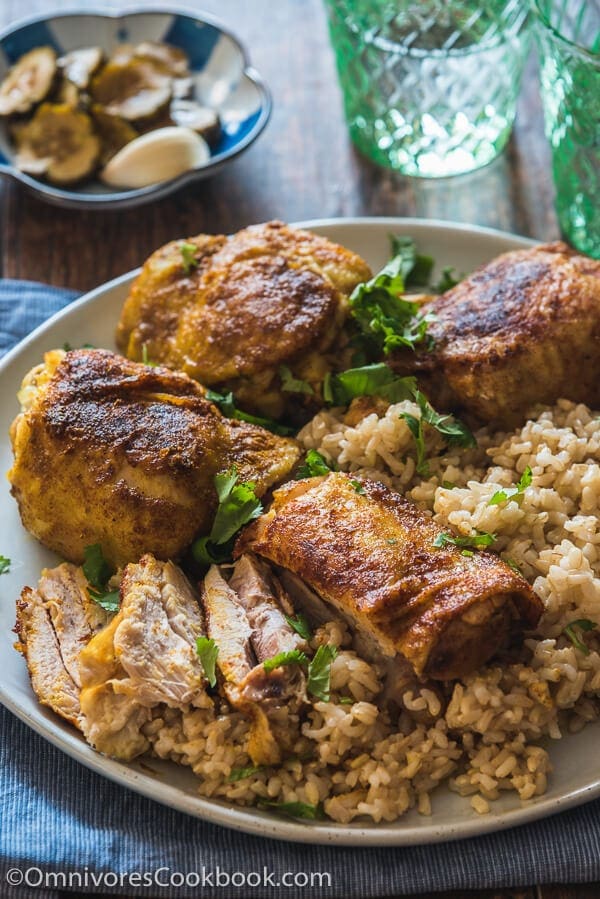
[/one_half]
[one_half_last padding=”0 0 0 2px”]
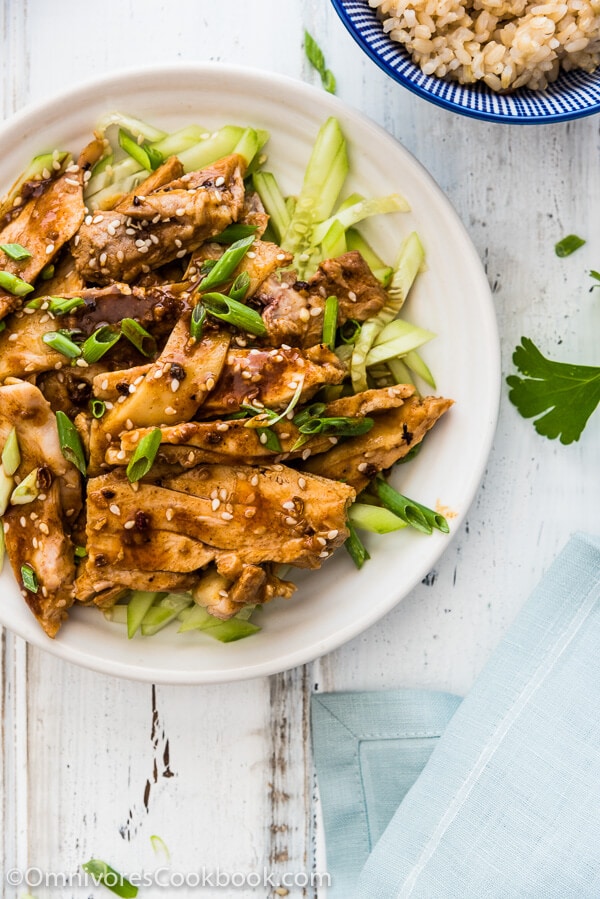
[/one_half_last]
Cooking step-by-step
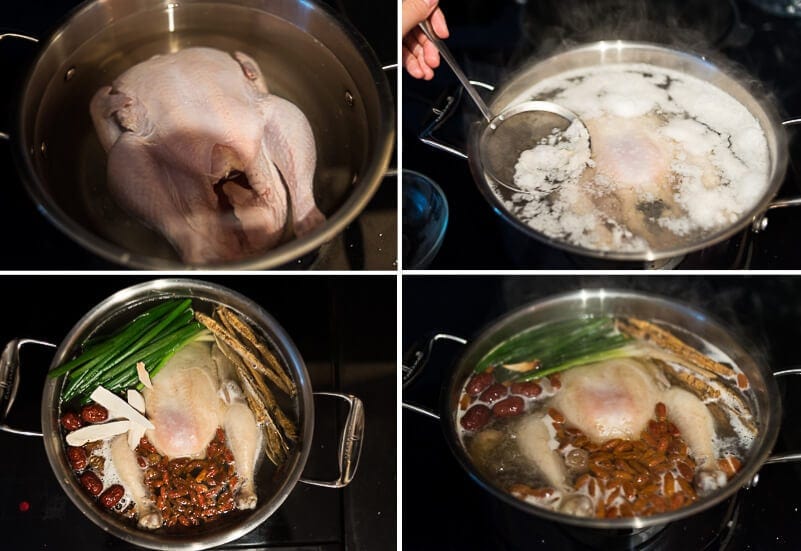

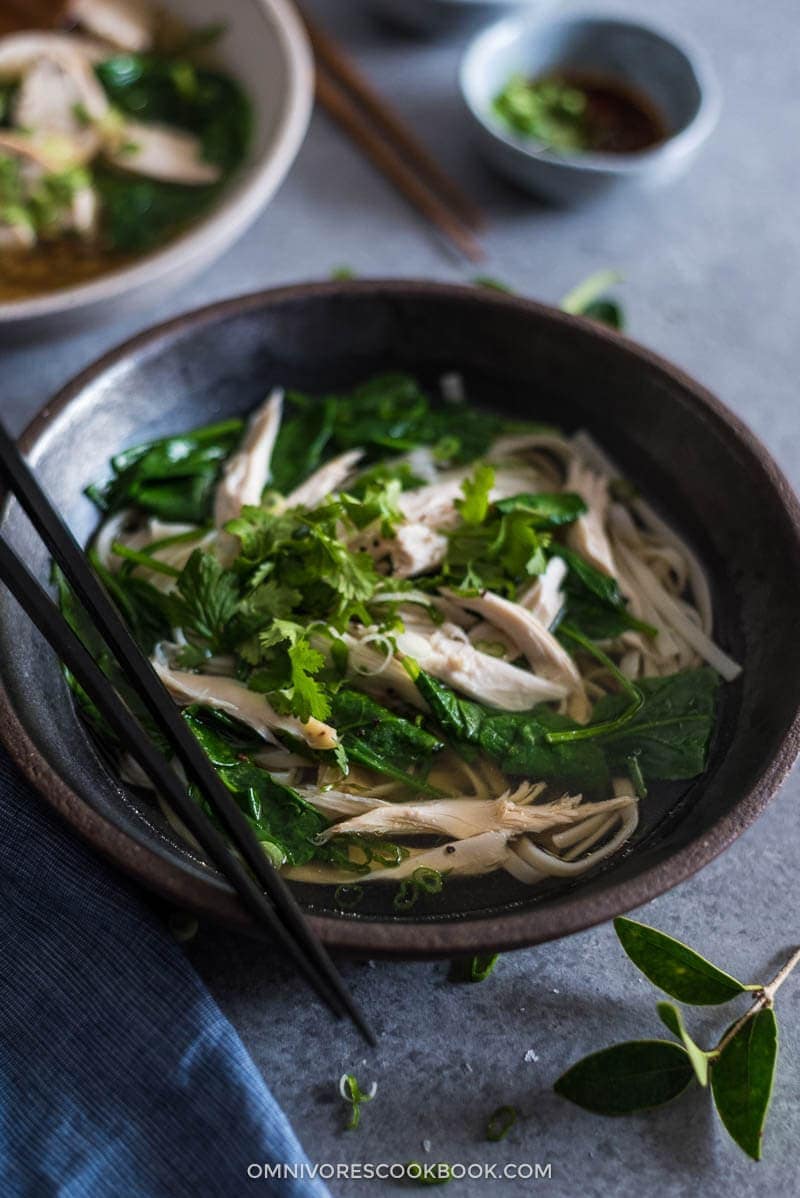
Just as popular as chicken is in the US, Chinese culture passionately believes in the power of chicken soup to heal the mind, body and soul. I hope you love the Chinese version as much as I do. Happy cooking!
More Chinese herbal recipes:
Disclosure: I’ve received these herbal mixes to test recipes but this is not a sponsored post. I love the quality of the soup mix so much I wanted to introduce it to you as well. The owner of the shop Cindy is an expert in Chinese herbs and medicine, and helped me to better understand healing soups and introduced me to the benefits of Chinese herbs. Thank you again Cindy!

Chinese Herbal Chicken Soup
Ingredients
- 1.5 to 2 kilograms (3 to 4 pounds) bone-in skin-on thigh (or whole chicken) (*Footnote)
- 1 thumb ginger , sliced
- 4 green onions
Herbal Mix
- 1/4 cup goji berries Gou Qi Zi
- 10 dried longan Long Yan Rou
- 10 pieces Chinese wild yam Huai Shan
- 5 dried dates Hong Zhao
- 5 pieces codonopsis Dang shen
- 4 pieces astragalus Huang Qi
Serve
- Chopped cilantro or green onion for garnish
- Salt and pepper
- Cooked noodles for noodle soup (Optional)
- 4 to 6 cups vegetables such as baby spinach, broccoli, and / or mushrooms (Optional)
Instructions
Stovetop
- Add chicken into a medium size pot. Add 6 to 8 cups water, until just covering the chicken. Bringing the water to a simmer over medium-high heat and turn to medium-low heat immediately. Simmer for 30 minutes. Skim off the brown foam from top of the soup and discard.
- Add ginger and green onion. Rinse the herbal mix under tap water and add to the soup. Simmer for at least 1 hour for a milder soup, or up to 3 hours for a darker and richer soup.
Slow cooker
- Add chicken, ginger, green onion, and herbal mix into a slow cooker and 6 cups water to cover. Cook on low for 6 to 10 hours or on high for 2 to 4 hours, depending on the richness of the herbal flavors you prefer.
Pressure cooker
- Add chicken, ginger, green onion, herbal mix and 6 cups water in a pressure cooker. Cook at high pressure for 30 minutes. If using an Instant Pot, choose manual, and set timer to 30 minutes. If using a stovetop pressure cooker, cook over medium high heat until high pressure is reached. Turn to medium low heat. Continue to cook 30 minutes.
Serve
- Skim chicken fat from top of the soup and discard. Filter the soup with a fine mesh to remove the herbs. From the herb mix, the red dates, goji berries, and Chinese yam are all edible. You can either serve them with the soup or discard them with the rest of the herbs.
- At the end of cooking, remove chicken from the pot and transfer to a plate to cool, so you can begin to shred it.
- (Optional) Add vegetables into the soup and simmer until the vegetables are just cooked through.
- (Optional) You can add cooked noodles to make the dish more substantial.
- Garnish with chopped cilantro or green onion and serve hot.
- Check this post to learn more ways to cook with leftover chicken.
Notes
- Always use bone-in dark meat (leg and / or thigh) to allow this soup to develop a rich flavor.
- Alternatively you can use the chicken back and neck with a longer cooking time (3 to 4 hours on stove top or 8 to 10 hours in slow cooker). Please note, the longer cooking time also means a darker and more herby soup.
- If you like like white meat, add chicken breast at the beginning and take it out once its just cooked through. It takes about 20 to 30 minutes simmering on the stove top and about 3 hours in the slow cooker (on low). The weight of chicken breast should not be included to make this soup.
If you give this recipe a try, let us know! Leave a comment, rate it (once you’ve tried it), take a picture and tag it @omnivorescookbook on Instagram! I’d love to see what you come up with.













When I first received your emails I just printed the recipes now I am reading and printing your iructions. You give so much information. Thank you so much
Hi Virginia, I’m glad to hear my post is helpful! I hope you enjoy the dish and happy cooking 🙂
I just receive your email with the recipe for the Chinese Herbal Chicken Soup and when you mention that you can add noodles with I just needed to try this and so I went onto the site you suggested and order two bags, should be receiving my order before the end of the week and will try my hand at this. Thank you for you do have great recipes that I love and enjoy cooking.
Hi Alfred, I’m so glad to hear you decided to try out the herbal soup mix! I hope you enjoy it as I do!
Making it into a noodle soup is the best way to prepare dinner. I also brown the boiled chicken with salt and pepper, so you have crispy chicken on top of the soup. Yum!
Happy cooking and let me know how your dish turns out 🙂
Hello Maggie, and yes I did make the big pot of that Chinese Herbal Chicken soup, and I had my doubts at first because while it was cooking in the slow cooker it had a slight pungent smell at first but as time went along it has gotten better not to mention the rich dark color. In the end it was great. of course I made all for myself and been on a soup kick. Thank you again for that great recipe.
Hi Alfred, I’m so glad to hear your experiment with Chinese herbal soup turned out well. Yes these herbs might be a bit pungent, but the longer you cook it, the flavors will turn mellow and blend into the soup better. I just caught a cold lately so I’m a soup kick now myself lol
Have a great week ahead 🙂
Is there a vegetarian option for the herb mix? I love Chinese flavors and the idea of an herbal broth that departs from the herbs I usually use is enticing.
Hi Caryn, I’m pretty sure there is a vegetarian option for herbal soup. I’ll be testing the recipe in the next few days and keep you updated on this!
Could you tell me which herbs you usually use in your broth? I’m thinking about ginger, garlic, onion, carrots, celery, shiitake mushroom, coriander, with a bag of this herbal soup mix.
That sounds very good to me. Maybe I’ll add some of the Lily flowers, too. I loved the recipe for Buddha’s Delight. It was so flavorful.
My go-to vegetarian soups start with a corncob broth made with some peppercorns, parsley, thyme, and a bay leaf. I grow these herbs, so I use them often. In the summer I may lean more toward basil, oregano and cumin. I’ve discovered that corncobs and dried mushrooms bring a richness and flavor to vegetarian broths that the usual recipes lack.
Hi Caryn, yes I think lily flowers definitely add great flavor to the soup. And thanks for sharing the idea of using corn cob! I saw it in pork soup back in China sometimes and it was so tasty. And I’d like to use bay leaf in all my stock too. Although I would be careful about parsley and thyme. Since the dry herbal mix in this recipe will be quite strong, I think I’ll skip these two. I love cumin and oregano too. Hmmm so many options!
Thanks for the suggestion about omitting parsley and thyme. I thought perhaps the best way might be to simply make a plain corncob broth when I’m working with the herb mix. I have even used frozen corn on the cob in the winter to make this broth, and it was delicious. Thanks for the encouragement. I’m looking forward to trying the herb blend you recommended.
Hi Caryn, I just tried cooking the vegetable broth this weekend. I added 3 corncobs, 1 daikon radish, some shiitake mushrooms, carrots and ginger. It was very delicious! But like you said, I bet it will be very good even you only use the corncob. Next time I’ll add bamboo shoot and skip carrot, so the soup will be less sweet.
Happy cooking Caryn! I hope you like the herb mix and your soup turns out great 🙂
Wonderful! Thanks for your response. I can understand how it might be too sweet with corn cob and carrot both. I’m looking forward to receiving the herb mix and experimenting.
Maggie I definitely love your works! I was wondering did you manage to figure out a replacement for the meat options to plant based alternatives?
What can you do for Vegan herbal soups.
Good question Margaret! I think it will be similar to making a vegan stock, but the herbal soup mix will add a richer flavor to it. I’ll be testing a vegan recipe this week and keep you updated!
Hi. Thank you for this recipe! I have tried many of them but this came when we are all sick! So I was going to make chicken soup but will try this today. Thankful I was able to find most of the ingredients. Can I cook it longer for bone broth?
Hi Teri, yes you can cook it long for bone broth. The herbal flavor will get even stronger, so depends on how herby you want the soup to be, you can slightly reduce the quantity of Astragalus Root and Codonopsis Root.
Enjoy the soup and hope you recover soon!
Maggie, thank you for your answer and suggestion. I will do as you suggest!! Thank you also for all your recipes. My family has enjoyed them. I’m fourth generation part-Chinese American whose mother didn’t cook so I’m so happy to learn from you.
You’re the most welcome Teri and I’m glad to hear you find my recipes helpful! Let me know how your soup turns out! I’m excited to trying it out in my own kitchen 🙂
Hi Maggie,
I’m thrilled to have found your blog. My family has been cooking soups since I was little, but growing up I didn’t like the kitchen. I enjoy cooking very much now and have been reading how important bone broth is for maintaining health. Your recipes and the information you provide have inspired me to follow my family roots once again. Thank you !
Hi Ali, I’m glad to hear you found my post useful! Yes bone broth is definitely great for maintaining health, and plus, it’s so delicious!
I buy paper packaged broth sometimes, but whenever I have time, I’ll make a big batch and store them in the freezer. The homemade one contains way more collagen and less sodium. So I highly recommend it!
Happy cooking and hope you enjoy the dish!
I’m glad to found your blog while searching chicken soup. Yum. I will check it out the herbal mix. Plus I’ve just signed up and received the ebook. Thank you very much.
Hi Phuong, you’re the most welcome! I’m glad to hear that you’re interested in trying out the soup and would like to cook more Chinese food! Let me know how your cooking goes 🙂 Have a great week ahead!
Hi,
Love all your recipes, they bring me back to China and its flavours.
Do you know where I can find this healing ingredients in Italy (even ordering online)?
Thanks
Stefania
Hi Stefania, if you could find an Asian grocery store, you might able to find these ingredients in separated packages. Just bring the recipe with you, and ask a staff to help you find the ingredients.
Or you can buy it online from here: http://bit.ly/HerbalSoupMix1
The international shipping rate is not too bad if you use the first class package.
Chicken noodle soup Chinese style! 😀
I’d recently bought a pack of dried herbs from my local Asian grocery store and it happened to have almost exactly what you listed in this recipe… It turned out really delicious! I cooked it on my stovetop and used chicken legs/thighs. I doubled the amount of ginger and added some garlic for the stock.
I added some tenderstem brocolli and some julienned carrots before serving.
For the dipping sauce, I mixed some crispy chilli, onion and szechuan peppercorns in oil with a bit of honey and rice vinegar.
I loved it, and so did my family!
Hello, thank you for the wonderful recipe. Root and Sprig sell a postpartum herbal soup mix that I would like to make in advance and freeze to eat after delivery. Do you think freezing will diminish the health benefits of the soup?
Hi Megan, I think you can freeze the soup without any problems!
THANK YOU for the recipe. It is very similar to another I had found, but far more specific in measurements and directions, which I truly appreciate.
I have a question I hope you can answer. The astragalus I ordered online came chopped up instead of in whole pieces. Is it still ok to use? How much would you recommend? You have here four pieces, but I don’t know how big the pieces were before they were chopped. Thank you so much!!
Hi Samantha, it’s totally OK to use the chopped astragalus. I’m afraid I don’t have the measurement in grams since I posted this recipe a long time ago. I do remember the astragalus was quite long, about the length of my hand (from the tip of my fingers to the end of my palm). Hope that helps!
Yes, thanks very much!
Is there a vegetarian option for the herb mix? I love Chinese flavors and the idea of an herbal broth that departs from the herbs I usually use is enticing.
Hi Daniel, the herbal mix itself is vegetarian. You just need to use a different broth base such as a vegetable broth you like.
Hi Ms. Zhu I was wondering since I have such a huge family including in-laws would tripling this recipe be fine? Even the herbs?
Yes, you can definitely double or triple the recipe. If you increase the liquid, you should also increase the herbs.